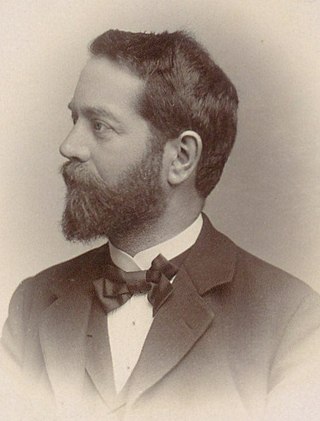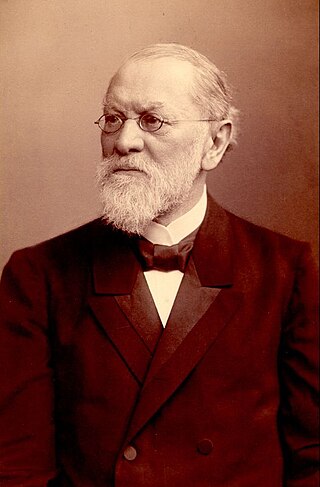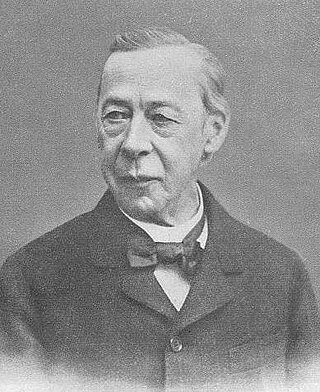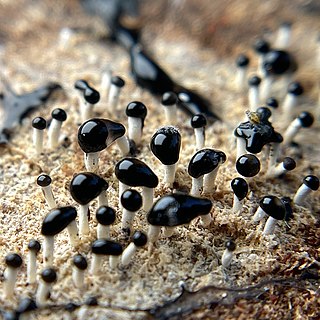Related Research Articles

Felix Christian Klein was a German mathematician and mathematics educator, known for his work in group theory, complex analysis, non-Euclidean geometry, and the associations between geometry and group theory. His 1872 Erlangen program classified geometries by their basic symmetry groups and was an influential synthesis of much of the mathematics of the time.

Nathanael Pringsheim was a German botanist.

The Nectriaceae comprise a family of fungi in the order Hypocreales. It was circumscribed by brothers Charles and Louis René Tulasne in 1865. In 2020, an Outline of fungi was produced and listed 70 genera and about 1,336 species.

Volemitol is a naturally occurring seven-carbon sugar alcohol. It is a substance widely distributed in plants, red algae, fungi, mosses, and lichens. It was also found in lipopolysaccharides from E. coli. In certain higher plants, such as Primula, volemitol plays several important physiological roles. It functions as a photosynthetic product, phloem translocate, and storage carbohydrate.

Karl Emanuel Robert Fricke was a German mathematician, known for his work in complex analysis, especially on elliptic, modular and automorphic functions. He was one of the main collaborators of Felix Klein, with whom he produced two classic, two-volume monographs on elliptic modular functions and automorphic functions.

Puccinia recondita is a fungus species and plant pathogen belonging to the order of Pucciniales and family Pucciniaceae.

The Hysteriaceae are a taxonomic family of fungi and the only extant family of the order Hysteriales. Members of the Hysteriaceae are defined by the possession of a sexual structure called the hysterothecium, an elongated structure that opens by a longitudinal slit and releases sexually produced spores. The family is widely distributed, with many species found in temperate regions, and most are saprobic on wood and bark, although a few are parasitic on plants.

Fuscoporia torulosa is a species of bracket fungus in the genus Fuscoporia, family Hymenochaetaceae. A wood-decay fungus, it causes a white rot of heartwood in dead and living hardwood trees in Europe, and in coniferous trees in North America.

Hermann Traube was a German mineralogist born in Ratibor, Silesia. He was the son of chemist Moritz Traube (1826–1894).

Lecanicillium lecanii is now an approved name of an entomopathogenic fungus species, that was previously widely known as Verticillium lecanii (Zimmerman) Viegas), but is now understood to be an anamorphic form in the Cordyceps group of genera in the Clavicipitaceae. Isolates formerly classified as V. lecanii could be L. attenuatum, L. lecanii, L. longisporum, L. muscarium or L. nodulosum. For example, several recent papers, such as Kouvelis et al. who carried out mitochondrial DNA studies, refer to the name L. muscarium.

Eduard Wölfflin was a Swiss classical philologist. He was the father of art historian Heinrich Wölfflin.
Friedrich Hermann Traugott Vogt was a German philologist. He was the son of theologian Karl August Traugott Vogt (1808–1869).

Richard Paul Wülker, until 1884 surname spelled as Wülcker was a German Anglist.

Purpureocillium atypicola is a species of fungus, previously known as Nomuraea atypicola, in the family Ophiocordycipitaceae with no subspecies listed in the Catalogue of Life. There are records of this mushroom from Japan, Australia and New Zealand.
Capronia mansonii is a mesophilic black yeast that is a part of the Herpotrichiellaceae. The species is uncommon in nature but is saprotrophic in nature and been discovered on decaying plant matter, particularly wood. This fungus is naturally found in the Netherlands and has successfully been cultured in lab. It is a teleomorph of the ascomycota division and possesses brown spores.
Marcelle Louise Fernande Le Gal was a French mycologist and lichenologist, and a pioneer of taxonomy of the Pezizomycetes.
Leucocoprinus brunneotegulis is a species of mushroom producing fungus in the family Agaricaceae.

Pleurotus cystidiosus, also known as abalone mushroom and maple oyster mushroom, is an edible species of fungus in the family Pleurotaceae, described as new to science by mycologist Orson K. Miller Jr. in 1969. It can be cultivated, with spores and growing kits being available commercially. Antromycopsis macrocarpa is the anamorphic form of this species.

Pleurotus albidus is a species of edible fungus in the family Pleurotaceae. Found in Caribbean, Central America and South America, it was described as new to science by Miles Joseph Berkeley, and given its current name by David Norman Pegler in 1983. It grows on trees such as Salix humboldtiana, other willows, Populus and Araucaria angustifolia, and can be cultivated by humans. Phylogenetic research has shown that while it belongs to P. ostreatus clade, it forms its own intersterility group.
References
- ↑ Icones fungorum hucusque cognitorum.-Pragae, JG Calve 1837-1854. AKJ Corda, 1842
- ↑ Preuss, Linnaea 25: 77 (1852)
- ↑ Bainier, Bull. Soc. mycol. Fr. 22: 211 (1906)
- ↑ Zycha, Krypt.-Fl. Brandenburg (Leipzig) 6.6: 158 (1935)
- ↑ Zycha, Siepmann & Linnem., Mucorales (Lehre): 129 (1969)
- ↑ Schulzer, in Schulzer, Kanitz & Knapp, Verh. zool.-bot. Ges. Wien 16(Abh.): 37 (1866)
- ↑ Morini, R.C. Secc. Accad. Sci. Ist. Bologna, N.S. 6: 87 (1902)
- ↑ Lythgoe, Trans. Br. mycol. Soc. 41(1): 140 (1958)
- ↑ Bonord., Handb. Allgem. mykol. (Stuttgart): 125 (1851)
- ↑ J. Schröt., in Engler & Prantl, Nat. Pflanzenfam., Teil. I (Leipzig) 1: 128 (1894)
- ↑ Pound, Minn. bot. Stud. 2: 99 (1894)